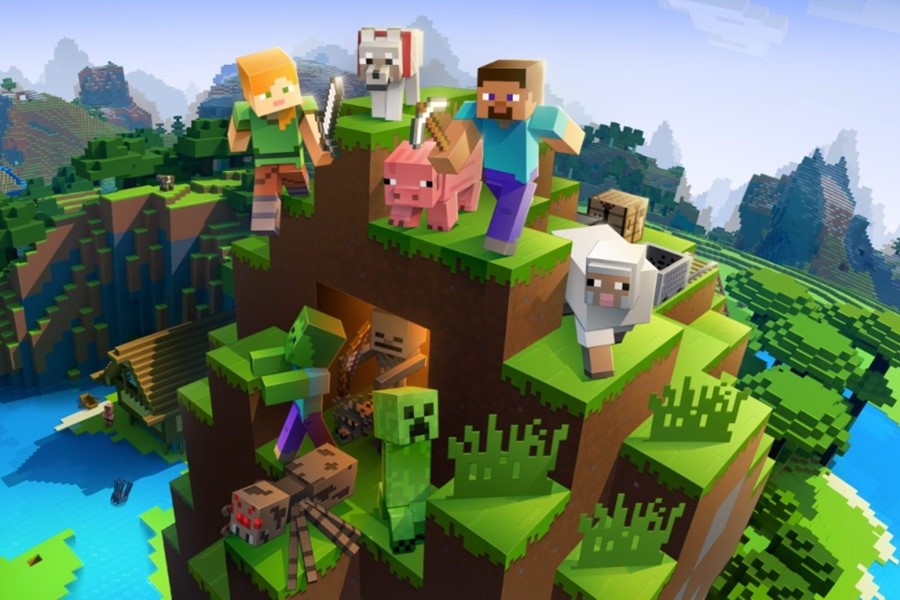Phaidon is honouring over seven decades of video game design with Game Changers: The Video Game Revolution – Dazed speaks to the book’s contributor Simon Parkin to find out more
Game design is one of the marvels of the modern age. Ever since computer programmers in the 1950s uncovered the potential for virtual play, the technology has developed at an exponential rate. Whether you came to gaming in the era of pixelated 8-bit side-scrollers, the PS2 era of burgeoning 3D graphics, or today’s advancements in photorealistic graphics and real-time lighting, the form has always relied on a synergy between different creative and technological disciplines, be that design, illustration, programming or creative writing. It’s this interdisciplinary approach that has enabled video games to constantly evolve and innovate, while helping the industry become the biggest commercial player in entertainment.
Now venerable arts publisher Phaidon is honouring over seven decades of video games in a new book: Game Changers: The Video Game Revolution. Compiled by a list of industry experts, the book features a comprehensive A-Z guide to the history of video games and their evolving design, with 300 entries exploring the significance and wider cultural impact of iconic titles, lesser-known indie-gems, genre-defining blockbusters, consoles, accessories, developers, and more.
Accompanying this in-depth excavation into the evolution of video game design and technology are two essays, one written by India Block, the deputy editor of the international quarterly design journal, Disegno, and another author and journalist Simon Parkin.
Today is the day! 'Game Changers: The Video Game Revolution' is out now.
— Phaidon 100 (@phaidonpress) September 14, 2023
🎮 Video features iconic games by:@ustwogames@CCPGames@_Toukana@WilliamChyr
📘 Featuring original essays by @SimonParkin and @indiablock: https://t.co/4rgLG2mPQVpic.twitter.com/FHqXrb0Obb
“Phaidon approached me and said they were doing a book celebrating video games,” says Parkin. “They asked if I would help, initially, just pull together that list of what the games to be included could be. So we sat down and put together a massive spreadsheet, adding loads of titles in there. Then they asked if I would like to write one of the two introductory essays.”
Parkin’s essay acts almost like a pocket history of the video game industry, moving through the development of the medium chronologically, while also considering gaming’s impact on culture more broadly. Dazed chatted to Parkin all about the book and how gaming has grown, shifted and mutated over the last 70 years.
In your essay you write about the diversification of video games, both in terms of genre but also in the scope of development. From a design perspective, what do you think this has done for the medium?
Simon Parkin: In the 1980s, there was this real outbreak of so-called bedroom coders. You had people who were able to use these computers, called the BBC Micro, which were part funded by the UK government, to learn to program and ultimately release their own games on cassettes. It was possible for a person on their own writing a game in their bedroom to become a huge success. That changed in the 90s when things became more industrialised. But with the rise of digital distribution, instead of having to get your game onto the high street, you can put it on the internet and sell it on Steam, for example. As a result, there was another big surge of one-or-two-person development teams who were able to get their games out into the world and find huge success like that. That changed the kind of games that were being made. They would be, perhaps, smaller in scope, but you could take more creative risks and tell stories that were perhaps more politically pointed. I would say we’re seeing the pendulum go back a little bit now. And because player expectations for the look and complexity of games are higher than ever, it’s much harder for a one-or-two-person team to see that kind of success again. You’re seeing indie game developers that now have teams of 15 and 20 people.
You write about how shifts in culture and communities have impacted the design of video games. How do you think things like streaming, YouTube and content creation have affected things?
Simon Parkin: It’s definitely had an effect. If you think back to maybe ten or 15 years ago, it really looked like Uncharted and The Last of Us were the future of games. You had these very cinematic and linear games where the player essentially roleplayed as the lead actor in a film. But there wasn’t much latitude in terms of what the player could do. Then, with the rise of Twitch and YouTube, streamers are looking for unique moments in games that are a one-off, that their audience can see. As a result, the focus for designers became giving players a suite of tools that allows unexpected things to happen. Minecraft is perhaps the first really big example of this where it’s really just a box of Lego. Or Legend of Zelda: Breath of the Wild or Tears of the Kingdom.

What do you think things like live-service games, micro-transactions and F2P platforms like League of Legends and Fortnite have done for game design?
Simon Parkin: The monetisation of games has always had a big bearing on their design. If you go back to the earliest arcade machines, they were meant to be played for short periods and designed to escalate in challenge very quickly. You put your 50 pence coin in, and the game designer wants you gone within two and a half minutes so they can get the next person on and get their money. That’s also true today. I think there’s a variety of ways in which game makers now monetise their games and you can see how whichever monetisation choice they go for then affects the design of those games. With an MMORPG like Final Fantasy XIV, it’s a monthly subscription and they’re trying to create vast amounts of content that keep you engaged for a very long time. But there are also games like Fornite or Call of Duty Warzone that give you cosmetics and items you might want to buy for your character. Probably the most traditional monetisation route is where you hand over whatever it is that the developer is asking for and then you get to keep your game forever. That’s probably the way in which the economics of their game selling has the least to do with the way in which the game is designed and perhaps offers developers the greatest freedom.
A book like this helps when it comes to video game preservation. But why do you think that there has been less effort or emphasis on the historical preservation of older video games, consoles and technology?
Simon Parkin: There is this idea that games are almost like appliances, where advances in technology make older iterations redundant. That was certainly true in the 90s and early 2000s. It was very rare for a publisher to go into their back catalogue to resell a game that had been a big success seven years earlier because there was a sense that no one would want to play it if it had been superseded by more modern technologies. It took a while, I think, for game companies to wake up to the idea that they had these valuable libraries that they could exploit or bring back in interesting ways.
The other thing is that video games run on specific hardware, particularly in the console space. So it’s not just a case of running code from the 90s on the technology from the 2020s; you have to go through various acts of reshaping to make it all work. That costs money and so there’s the question of return on investment. It’s a fraught subject at the moment because the Video Game History Foundation just released a recent report saying that 87 per cent of games released before 2010 are impossible to buy now. That’s a massive section of culture that's just disappeared over the waterfall.
Game Changers: The Video Game Revolution is published by Phaidon, and is out now.
Join Dazed Club and be part of our world! You get exclusive access to events, parties, festivals and our editors, as well as a free subscription to Dazed for a year. Join for £5/month today.




